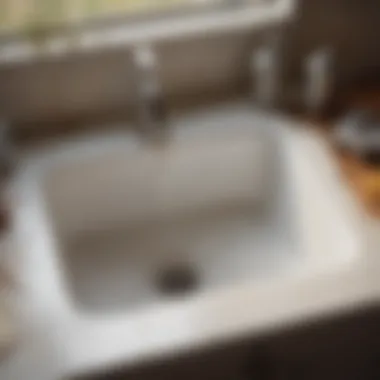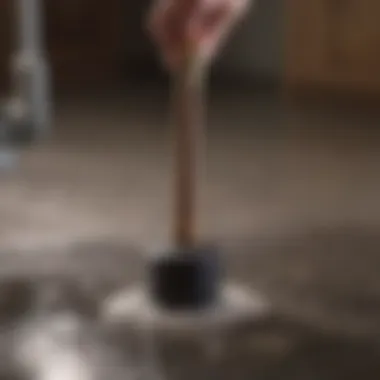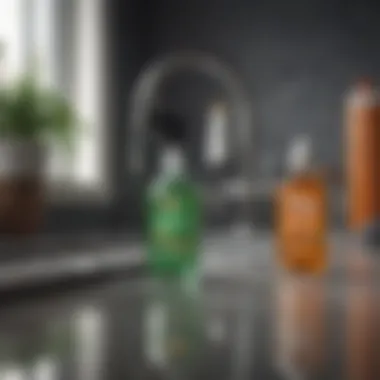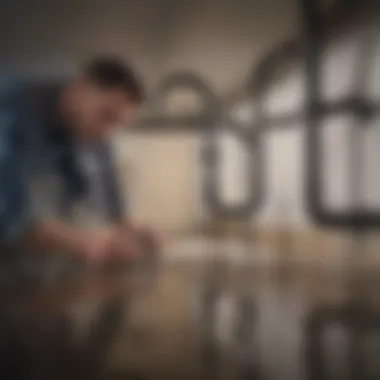Effective Ways to Unclog Your Plumbing Pipes


Intro
Understanding plumbing systems and their potential blockages is vital for every homeowner. Many household tasks can feel overwhelming, yet clogged pipes and the rush of water draining incorrectly are widespread issues. Clogs can stem from various sources, particularly oil, grease, hair, soap residue, and foreign objects inadvertently washed down the drain.
The importance of knowing how to effectively unclog plumbing pipes cannot be overstated. A proactive approach diminishes the chance of recurrent clogs and keeps your plumbing in peak condition. With a little effort and understanding, homeowners and DIY enthusiasts alike can implement practical solutions equipped with essential insights for the upkeep of their beloved homes.
Throughout the following sections, we will cover effective techniques for different types of clogs. Guidance is provided for common methods and sustainable practices aimed at long-term functionality of plumbing systems. This information claims relevance not just to the immediate task but assures peace of mind for future plumbing issues.
Understanding Common Causes of Clogs
Most clogs occur due to a combination of buildup over time and neglect of maintenance. Primary contributors include:
- Soap scum and buildup from detergents used in washing tasks.
- Hair accumulations from bathroom sinks and showers.
- Food particles and grease solidifying in kitchen drains.
- Foreign objects like toys or sanitary products obstructing the flow.
Each scenario warrants specific approaches tailored to nature of the blockage:
- Chemical clog removers: Often found in shopping aisles, these can be effective for cases involving organic build-ups.
- Manual removal using plungers or hand snakes can help with more stubborn blockages requiring physical attentiveness.
Accomplishing proper drainage through these methods fosters self-sufficiency, requiring only tools often found at home or acquired inexpensively.
Prevention Strategies
Avoidance is the best policy towards maintaining clear plumbing. Effective preventive measures include:
- Regular Maintenance: Monthly checks can identify early signs of trouble. Routine use of strainers catches excess debris and can easily be cleaned up.
- Limit Disposal: Avoid putting down problematic materials. Never use sinks for garbage disposal. Educate members of the household on proper disposal techniques.
- Routine Cleaning: Occasionally clean plumbing vanity and sink traps. This care will help counteract fundamental clog-creating conditions.
Invest in these approaches helps not only in flourishing aesthetic functionality through immediate repairs but propagates a responsible home environment.
“An ounce of prevention is worth a pound of cure.” - Benjamin Franklin
Culmination
Unclogging plumbing pipes might seem a trivial subject when tackling household maintenance; however, it embodies the underlying complexity of everyday home care tasks. Understanding causality, provides efficient solutions, and advocating preventive measures bolster homeowner independence and boosts longevity of plumbing systems. As mastering such tips can also bring forth satisfaction gained from self-tackling household issues, they indeed pay dividends in practicality and sustainability. Thus, a systematic vigil over our plumbing enhances the overall robustness of our inspiring homes.
Prelude to Plumbing Clogs
Understanding plumbing clogs is essential for any homeowner. Regularly dealing with clogged pipes can lead to various complications, from minor inconveniences to serious plumbing issues. Knowing how to recognize and address a clog is critical not only for immediate resolution but also for prevention and maintenance in the long run.
Understanding Common Causes of Clogs
Clogs occur in plumbing due to different reasons, mostly involving the accumulation of materials that block the flow of water. Here are some common culprits:
- Hair: A major contributor in bathrooms, hair can bind with soap residue and create a significant blockage.
- Grease: In kitchens, grease build-up from cooking can mix with food scraps to form tough clogs.
- Foreign Objects: Sometimes, objects not meant for drains, like toys or sanitary products, accidentally get disposed of and cause clogs.
- Soap Scum: Over time, soaps can leave behind a residue that builds up and hardens, particularly in hard water areas.
- Mineral Buildup: In areas with hard water, mineral deposits can accumulate inside pipes leading to restricted flows.
Identifying these common contributors can help in preventing future issues.
Identifying Signs of a Clog
Recognizing the signs of a build-up can assist in managing plumbing before it becomes a major issue. Here are some signs to look out for:
- Slow Draining Sinks or Showers: If water backs up slowly while you are using the sink or shower, it signals that there could be a clog developing.
- Foul Odors: Bad smells originating from the drains may indicate decay or waste caught in the pipes.
- Gurgling Sounds: Unusual noises when you flush the toilet or use the sink can mean that air is trapped due to a blockage somewhere down the line.
- Water Backflow: When water drains back up instead of flowing down, this is a clear indication that something is obstructing the pipes.
“The sooner you detect these signs, the easier it will be to clear your plumbing issues.” Taking preventive measures can greatly reduce unnecessary trouble.


Tools and Materials for Unclogging
Unclogging plumbing pipes is a multifaceted process that often requires specific tools and materials tailored for different situations. The right equipment not only ensures efficiency but also minimizes the potential for damage to the plumbing system. Selecting the right tools will make the process smoother. Furthermore, understanding how these tools function can save time, frustration, and money in the long run.
Essential Tools for DIY Plumbing
Clearly, doing plumbing work requires a set of essential tools. Each of these tools serves a distinct purpose and can help resolve various clogging scenarios.
- Plunger: This device is fundamental for addressing simple clogs. A strong, high-quality plunger creates a vacuum that helps to dislodge debris.
- Drain Snake: A drain snake, also known as a plumber's auger, can reach deeper clogs. It coils through pipes and pulls out blockages that are otherwise inaccessible.
- Pipe Wrench: A pipe wrench tightens or loosens fittings. It is valuable for adjusting plumbing without breaking pipes.
- Bucket: When tackling clogs, a bucket gathers water and debris to avoid overflow. It is essential when using any chemical cleaners as well.
- Rubber Gloves: Protective gear is vital. Gloves keep hands clean and protected from harsh substances.
These tools together create a toolkit that empowers any homeowner or DIY enthusiast to tackle plumbing challenges effectively.
Household Items That Aid in Unclogging
Many household items can also serve as effective assists in unclogging. These everyday products offer economical choices for maintenance, safeguarding plumbing systems while using readily available substances.
- Baking Soda and Vinegar: This combination is a powerful natural cleaner. Baking soda absorbs odors, while vinegar cuts through grime and disrupts buildup. Together they unleash a fizzy activity that can clear minor clogs.
- Boiling Water: Simple yet effective, boiling water can melt soap scum or grease blockages in pipes.
- Dish Soap: This can work wonders on greasy obstructions. A few squirts in hot water can lubricate pipes and help dislodge the clog.
- Salt: Besides adding flavor to meals, salt has properties that help clean heavy residues when mixed with hot water.
Using these handy items can offer solutions that are both practical and effective, demonstrating that one need not rely solely on commercial products. Adopting these approaches often leads to a cleaner, clearer plumbing system and helps avoid excessive spending.
Basic Unclogging Techniques
Understanding basic unclogging techniques is vital in maintaining the functionality of your plumbing system. These methods, while simple, often prove to be effective first responses to common clog situations in home plumbing. Recognizing when to use a specific technique and how each method works can minimize the chances of needing more invasive interventions later on. It also reinforces the homeowner's ability to handle minor plumbing issues independently, saving time and reducing costs in the long run.
Using a Plunger Effectively
The plunger is possibly the most recognized tool for addressing clogs. Employing it effectively involves more than just pushing it up and down. Proper technique matters. First, ensure the plunger is designed for the type of fixture involved; for toilets, a flange plunger works best, while for sinks and tubs, a cup plunger is appropriate.
Start by adding some water to the sink or tub to cover the bottom of the plunger. This heightens its suction potential. Next, position the plunger over the drain, creating a tight seal. It's critical to push down forcefully, then pull up sharply, repeating this motion multiple times. The suction created will help break apart the clog effectively. If this initial effort doesn’t work, consider using a plunging rhythm rather than raw strength.
Knowledge of when not to use a plunger is equally essential. If the water is unusually stagnant or if the clog shows signs of severe backing up, deeper issues may need to be assessed.
Chemical Solutions for Clogs
Chemical solutions for plumbing clogs can be crucial for dealing with tough blockages. These products often promise quick fixes, allowing homeowners to restore flow without needing professional help. Understanding the benefits and limitations of chemical cleaners will equip you to make informed choices about their use.
Some commercial products dissolve stubborn solids in pipes rapidly. Additionally, they alleviate frustrations related to slow drainage, which affects daily routines significantly. It is important to weigh the convenience offered by these products against possible dangers and environmental concerns.
Commercial Drain Cleaners Overview
Commercial drain cleaners are readily available in hardware and grocery stores. These cleaners usually come in two main types:
- Caustic drain cleaners contain ingredients such as sodium hydroxide. They work by creating chemical reactions that break down organic materials.
- Acidic drain cleaners, like those based on sulfuric acid, are often more potent. They quickly dissolve clogs, but can also pose risks if not handled properly.
Before considering these products, always check the label for the specific application and intended uses.
Using Vinegar and Baking Soda
Using vinegar and baking soda is a natural alternative to chemical cleaners. This method creates a foaming reaction that can help to dislodge light clogs.* To use this combination:*
- Pour half a cup of baking soda into the drain.
- Follow it with half a cup of vinegar.
- Let it sit for about 30 minutes.
- Finish with hot water to flush any loosened debris away.
This method is not only effective but also a safer option. Common household items do not cause significant harm to pipes or the environment.
Dangers of Chemical Cleaners


While chemical solutions have their uses, they also come with notable dangers.
First, these substances can be hazardous to physical health. Skin contact with strong acids or bases can lead to severe burns. If inhaled, fumes may cause respiratory distress.
Moreover, chemical cleaners can harm plumbing systems. Frequent use can erode pipes, leading to leaks and costly repairs. Environmental implications are also concerning; introducing harsh chemicals into the plumbing can contribute to water pollution.
Always use chemical products sparingly and follow safety precautions. Consider natural alternatives as a gentler choice when possible.
In speculating about plumbing solutions, consider the complete range of options available. While chemical solutions are effective for immediate challenges, long-term strategies should take precedence to maintain the health of plumbing systems.
Advanced Unclogging Techniques
Advanced unclogging techniques play a vital role for homeowners facing severe drain blockages, where basic methods may fall short. These situations require employing tools and skills that manage complex plumbing issues effectively. When conventional methods like plunging fail, utilizing advanced techniques not only resolves the current problem but also enhances the overall plumbing system.
Sometimes, deeply ingrained debris, grease build-up, or foreign objects lodging inside pipes need special equipment. Understanding advanced techniques can save you time and money in plumbing repairs, promote better drainage, and even prevent future clogs. Here, we focus on two fundamental methods: hydro jetting and using inspection cameras.
Utilizing a Hydro Jet
Hydro jetting is a powerful technique that employs a high-pressure water stream to clear clogs from the plumbing system. This method is particularly advantageous as it does not involve harsh chemicals. Instead, it harnesses the force of water to strain away silt, minerals, grease, and other debris, offering a thorough cleaning.
Benefits of Hydro Jetting
- Effectiveness: Hydro jetting can address even stubborn obstructions with ease.
- Long-lasting results: This method ensures that pipes remain clear for an extended period.
- Eco-friendly: Using only water, it provides an environmentally safe way to maintain drain health.
Considerations and Procedure
Before opting for hydro jetting, it's essential to assess your plumbing system, as high-pressure water can cause damage in older or fragile pipes. Ensure you seek professional service to avoid any complications.
Typically, the hydro jetting procedure involves:
- Inspection: Technicians will examine your pipes with a camera to locate the clog and assess the integrity of your plumbing system.
- Preparation: A proper setup is created to minimize water spillage.
- Jetting Process: Highly pressurized water jets penetrate the clogs and strips build-up away from inner pipe walls.
- Clean up: After the unclogging process, proper cleanup is done to ensure that everything is tidy.
Using an Inspection Camera
Utilizing an inspection camera is a crucial step before performing any clog removal treatment. This advanced tool allows for a visual assessment of the entire plumbing system. It is a non-invasive and practical option that saves both time and money when accessing issues within pipes.
Importance of Inspection Camera
- Precise Diagnosis: This tool provides clear images of not only the clogs but also pipe integrity or underlying issues like corrosion and cracks.
- Targeted Solutions: Identifying the location of the problem allows for tailored unclogging methods fitting specific situations.
Process of Using an Inspection Camera
- Image Capture: Professionals thread the camera through the pipes, using a flexible line for complete access.
- Video Playback: They can view live footage, pinpoint blockages and highlight damaged areas.
- Data Assessment: The images can help the plumbing technician establish an actionable plan to resolve the share issues.
Employing advanced unclogging techniques like hydro jetting and inspection cameras greatly enhances your chances of maintaining plumbing health. This ensures complex problems receive appropriate attention without further damaging the system. Being proactive in understanding your plumbing can truly save considerable resources in the long run.
Preventive Measures for Future Clogs
Preventive measures play an essential role when it comes to maintaining a clear plumbing system. Avoiding clogs is much more efficient and easier than trying to fix them once they occur. Moreover, employing preventive techniques not only enhances the lifespan of your plumbing infrastructure but can also lead to substantial cost savings over time.
When you take proactive steps, you significantly minimize the chances of future clogs and, subsequently, the need for frequent repairs. Preventive efforts allow you to safeguard your home's plumbing, ensuring that water flows smoothly. This becomes particularly important when you consider the potential complications that can occur from an ignored clog, leading to burst pipes or trapped sewage.
“An ounce of prevention is worth a pound of cure.”
Regular Maintenance Routines


Developing a regular maintenance routine adds structure to your plumbing care. Many homeowners neglect simple tasks that contribute to clear plumbing. Implementing routines helps you catch minor issues before they evolve into major headaches. Here's what you can do:
- Clear drains of hair and debris regularly. Remember that kitchen sinks can accumulate food particles, while bathroom sinks may trap hair over time.
- Inspect fixtures and pipes for leaks or corrosion frequently.
- Use enzymes or natural cleaners monthly. These solutions can break down substances before clogs form.
- Flush the system with hot water every few months, especially in the kitchen. Boiling water can dissolve grease that has clung to the pipes.
By engaging in these actions consistently, you ensure your plumbing remains healthy and operates efficiently. The effort involved is typically slight when compared to the potential benefit of fewer plumbing emergencies.
Proper Disposal Practices
Proper disposal of waste is critical in avoiding clogs. Harmful substances result in severe problems. Below are recommended disposal practices:
- Avoid pouring grease and oil down the drains. Once they cool, these substances will solidify and obstruct pipes. It's wise to use containers for collection that can be discarded in the trash.
- Discard food scraps properly. Consider using a compost bin instead of the sink composting. This change keeps food waste away from plumbing systems, reducing the chance of clogs.
- Limit non-disposable items. Items like baby wipes, cotton swabs, and other similar products should never be flushed down the toilet, no matter what packaging may claim.
By following proper disposal methods, you can help maintain clear plumbing over the long term. Make it a routine part of your cleaning efforts.
When to Call a Professional
Recognizing when to seek help from a professional plumber can make a significant difference in resolving plumbing issues effectively. Many homeowners attempt to tackle every problem, believing they can DIY their way to a solution. However, complex clogging problems may require experienced intervention. Ignoring this can lead to worsening situations, potentially resulting in costly damages.
Understanding your limitations is critical. Not all plumbing issues are straightforward. For instance, a simple hair clog might be an easy fix with a plunger, but a persistent blockage accompanied by leak or strange noises in the piping system could suggest a more serious issue. Knowing when the situation exceeds your skills is key.
Identifying Complex Issues
Identifying complex plumbing problems can be challenging without proper knowledge and tools. Some signs that suggest you need a professional include:
- Recurring Clogs: If you fix a clog only to have it return shortly after, the issue may be deeper within the plumbing system.
- Unusual Smells: Foul odors coming from drains could indicate decaying matter that requires immediate attention.
- Multiple Drain Clogs: If several fixtures experience problems simultaneously, it may mean that the main sewer line is clogged.
- Slow Drains: Persistently slow drainage across multiple pipes can signify systemic issues that need specialized equipment to diagnose and clear.
- Leaking Pipes: Substantial leaking or swelling floors might be a precursor to a burst pipe, which could incur significant repair costs.
These issues highlight the necessity of professional intervention. Trying to mitigate these scenarios without proper tools, like hydro jets or inspection cameras, could create additional problems.
Cost-Benefit Analysis of Professional Help
The cost of hiring a plumber could be the last barrier to seeking help. Yet, a cost-benefit analysis reveals various financial aspects and protections:
- Saving Time: Skilled plumbers can resolve issues faster than novices, resulting in minimized aggravation and disruption.
- Durability of Solutions: Professionals typically provide long-lasting fixes. A temporary solution may lead to multi-layered problems due to improper handling.
- Proper Tools and Techniques: Professionals come equipped with advanced tools that many homeowners do not possess. These tools can help reveal insights into complex issues, allowing for a comprehensive resolution.
- Prevention of Future Costs: Investing in professional help initially may prevent broader, more expensive repair needs later on.
Remember: While DIY routes could seem more economical at first glance, incomplete understanding can result in significantly higher expenses over time.
When considering these factors, it becomes clear that enlisting a professional can add value and quality to significant plumbing repairs. It ultimately enhances your home’s overall plumbing system efficiency.
Culmination: Ensuring Clear Plumbing
Unclogging plumbing pipes properly involves understanding various techniques and the nuances involved in addressing these household challenges. A successful unclogging process enhances efficiency and promotes long-term functionality of plumbing systems. The importance of knowing when to employ certain methods cannot be overstated; it saves invaluable time and minimizes potential damage to pipes.
Key elements discussed throughout this article highlight the necessity of both preventative measures and strategic unclogging techniques. Familiarity with the basic plumbing tools and household items for this purpose empowers homeowners and DIY enthusiasts alike. Additionally, following proper disposal practices and maintaining routine checks can greatly decrease the likelihood of severe clogs developing in the first instance.
Moreover, knowing when to call for professional help plays a critical role in mitigating more complex plumbing issues, ensuring a seamless experience while maintaining peace of mind. By applying the guidance presented here, one can achieve well-maintained plumbing that serves both daily comfort and safety.
Maintaining clear plumbing is not merely about removing blockages; it's about fostering a sustainable household environment.
Recap of Techniques and Tips
In summary, various methods were detailed for unclogging pipes effectively. Essential tools like plungers and drain snakes were explored, alongside common household items, such as baking soda and vinegar. These techniques are not merely quick fixes; they require using the right approach and exercising caution. Reminders from this article encompass:
- Regular maintenance routines: Implementing such routines aids in preventing clogs.
- Proper disposal practices: Reduce the introduction of harmful materials into pipes.
- Proactive unclogging: Switch promptly to the right method for the level of blockage at hand.
Final Thoughts on Plumbing Maintenance
Mastering plumbing maintenance requires continuous engagement with some fundamental principles. A solid understanding of basic plumbing systems combined with effective unclogging techniques allows individuals to tackle common issues with ease and confidence. To ensure clear plumbing effectively:
- Stay informed: Continually learning about plumbing care enhances problem-solving abilities.
- Engage in basic repairs: Simple tasks can discourage reliance on professionals for minor plumbing crises.
- Treat plumbing with respect: Knowing your pipes' limits ensures longevity.
Ultimately, investing time in understanding plumbing mechanics pays dividends through reduced costs and enhanced home functionality.



